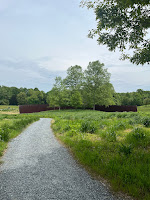Located on 230 acres in Potomac, Maryland, Glenstone, largest private contemporary art museum in the United States, is a venue where architecture and nature blend in perfect harmony. Curves and lines from the rolling hills and the minimalist buildings, design a landscape colored by patches of violet grass and yellow wild flowers. Birdsongs are an invitation to walk along the trails and discover the collection of outdoor sculptures. Spring is a perfect time for a visit.
Among the artists, Richard Serra is represented by three sculptures closely intertwined with the history of the site. The planned addition of Sylvester, 2001, influenced the selection of material and shape of the Gallery designed by the architect Charles Gwathmey. Like an anchor, the massive sculpture permanently located near the building, was first displayed in 2001 at the Gagosian gallery for the exhibition "Torqued Spirals, Toruses, and Spheres". Named after the British art critic David Sylvester, the work, part of the famous Torqued Spiral series, offers a unique experience while walking around and in the sculpture. The entrance is a narrow triangular passage shaped by the unstable edge of the curled sheet of steel. The more than thirteen foot high walls with inward and outward twists allow the light to project like a ribbon in between, and create during the walk a succession of geometric shapes born from the interplay between metal and sky. Visitors' voices and steps resonate in the claustrophobic space. In the heart of the sculpture, surrounded by the rough rusty metal, the only escape for the gaze is through an oculus filled with the blue-grey sky. Serra's comment "I am using a ton of steel to attain lightness" could not be more appropriate for this piece.
The trails in the woods become a zigzaggy boardwalk set over a stream and a marshy field to reach a pavilion. Of small size, it is imposing due to its thick concrete walls and wide open dark entrance. The building was designed by the architect Thomas Phifer in collaboration with the artist to house Four Rounds: Equal Weight, Unequal Measure, 2017. Inside, the cold grey bare concrete of the walls and the floor is warmed up by the orangy-brown Cor-ten steel of the four enormous cylinders arranged in the middle of the space. A soft natural light shines through sheaths of transparent glass supported by the ceiling's massive parallel beams. The imposing cylinders of unequal height and circumference, are of same weight "82 tons - the heaviest form that a foundry is able to forge". Numbers do not matter, they are just huge. The walk around, through, back and forth the installation provides a physical experience of the work, representation of the idea of weight. It also allows to connect with the artist as we share the awe he felt looking at the metal while visiting a boat yard with his father and later working in a steel mill. Benjamin Buchloh's statement in his essay for the catalog of the exhibition "Richard Serra Sculpture: Forty Years" at MoMA in 2007, feels very pertinent after looking at the work, result from a perfect harmony between the industrial material and the Minimalist aesthetic: "the artist as a designer with a renewed celebration of the artist as an industrial worker".
Lynne Cooke calls Serra's Contour 290, 2004, "one of his most mercurial works". The site specific sculpture ensconced between two hilly meadows can be approached from different paths but stays remote, a wavy line in the landscape, sometimes obscured by trees when seen from different viewpoints. Located exactly 290 feet above sea-level, following the topography of the land, it required a meticulous mapping and engineering to secure the massive structure (15 feet high, 223 length and 165 tons). Closely involved in the process, the artist walked through the site to plan for the work embedded with nature. It introduces a three dimensional view of the landscape and Serra "was more interested in a penetration into the land that would open the field and bring you into it bodily, not just draw you into it visually". In 2006, the scene was disturbed by changes brought to the trees' alignment. If the steel wall from Te Tuhirangi Contour, 1999-2001, in New Zealand appears in harmony with the site (from photographs), Contour 290 merely acts like an accessory to the landscape.
The term "architectural promenade" coined by Le Corbusier to describe "the intelligibility of a building given less through axonometric drawing than through the ways one moves through the space", applies perfectly to the visit of Serra's three sculptures "not objects we inspect but arrangements of space in which we move" (Buchloh). Hubris has to be part of the process of creativity, motivating the artist to redesign and domesticate nature with metal. Nature is resilient and follows its own rules but the massive sculptures, which at first sight seem eternal, show some vulnerability with their rusty haptic surface damaged not by the elements or time but by the visitors. Minimalism is about redesigning the space, here Serra "drawing in space" redesigns nature and sky. Does the sculptures' symbiosis with nature offer more than a casual walk? A spiritual experience? The artist makes his goal clear: "I don't think public sculpture is going to change the world, but I do think it might be a catalyst for thought. To see is to think and to think is to see."



No comments:
Post a Comment